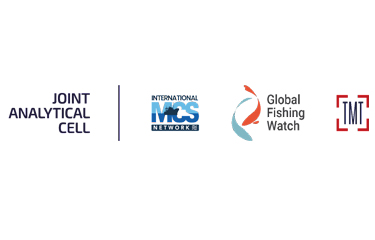A new collaboration by three data-driven campaign groups aims to give lower-income coastal states better access to fisheries intelligence, data analysis, and capacity-building assistance in the battle against illegal, unreported, and unregulated (IUU) fishing.
The collaboration was founded by the USAID-funded International Monitoring, Control, and Surveillance Network; Global Fishing Watch; a partnership between Google and the advocacy groups Oceana and SkyTruth; and TMT, a nonprofit known for its detailed database of IUU-related vessels and operators. Dubbed the Joint Analytical Cell (JAC), the project aims to harness innovative technology and fisheries expertise to increase data sharing and collaboration among governments and non-state actors in the fight against IUU.
The JAC will be a game-changer, as lower-income nations have struggled to battle illegal fishing in part due to a lack of access to technology and information systems, according to International Monitoring, Control, and Surveillance Network Executive Director Mark Young. Fishery management authorities “have traditionally relied on proprietary monitoring systems that have limited information sharing and are not available to all states,” Young said.
“[JAC] will set a precedent for a global shift toward greater use of open data, data analytics, and integrated technology to provide greater transparency of activities occurring in the maritime domain and strengthen fisheries monitoring, control, and surveillance efforts,” Young said. “Collaboration between states, nonprofits, and technology providers can help tackle IUU fishing by providing actionable data, credible intelligence, and capacity building to those that need it most, ultimately improving global fisheries management.”
JAC will build on existing tools created by the founding members such as Global Fishing Watch’s vessel-tracking map and related tools like its carrier vessel portal, as well as TMT’s Fisheries Analytical Capacity Tool, a “fisheries intelligence management system” that has uncovered details on the movements and ownership of vessels suspected of IUU activities.
“When taken to scale, [JAC] will mobilize the combined expertise of its partners and allow for more targeted analyses and actionable intelligence offerings,” Global Fishing Watch CEO Tony Long said in a press release.
According to the release, JAC was designed to create a more collaborative model and “will particularly focus on the strengthening of port controls, transhipment activity, and air and sea patrols.” Insights from JAC analyses will also be made available to “evidence-based international policy and legal processes that target the closure of loopholes that are exploited by illegal fishing operators.” Among the backers of the new initiative is Bloomberg Philanthropies.
The new JAC system, which will be showcased at the second United Nations Ocean Conference taking place in Lisbon, Portugal, in June, comes on the heels of the the creation of the Indo-Pacific Partnership for Maritime Domain Awareness, a similar intelligence-led initiative to assist poorer states in battling IUU. However, the two initiatives have no formal connections to each other, TMT Executive Director Duncan Copeland said.
“This was only just announced and it is still to be determined what systems and data sources will be made through that initiative,” Copeland told SeafoodSource. “However, the JAC has been developed to be able to work across and integrate different state and non-state partners and platforms, and already does so with several of the systems the U.S. and Pacific Islands are utilizing. As the [Indo-Pacific Partnership for] maritime domain awareness system develops in the Pacific, we anticipate that the JAC will have a role to play in assisting fisheries departments and regional fusion centers to be able to act and operationalize enforcement activities based on the strengthened maritime picture it should provide.”
The partners involved in the JAC initiative have all arrived at the conclusion that state and non-state actor cooperation and collaboration is essential, Copeland said.
“The opportunities that the appropriate data, the right tools and technologies, and targeted personnel training present to bolstering fisheries-enforcement capacities are enormous, but only if they are accessible and adapted to a national or regional context, and the Joint Analytical Cell has been formed to enable this objective,” he said.
Whitley Saumweber, director of the Stephenson Ocean Security Project at the Center for Strategic and International Studies in Washington D.C., U.S.A. said the Indo-Pacific Partnership for Maritime Domain Awareness is commonly perceived as directed at vessels from China, the source of the world’s largest-distant water fleet and the majority of IUU-related trawlers listed by various regional fishery management organizations.
“It’s something new and should, if implemented properly, help to address the shortage of capacity among smaller Pacific states in particular,” Saumweber said.
The new partnership, Saumweber told SeafoodSource, offers a few "novel elements," including greater access to commercially available radio data on activity at sea.
“This would presumably include synthetic aperture radar (SAR) data from satellites as well as potentially other data sources that could be used to identify vessel presence in an area beyond the acquisition of AIS [automatic identification system] information that has become a common but avoidable source of domain awareness,” Saumweber told SeafoodSource.
A second element, Saumweber said, is distribution of the information.
“This brings us to the second element, which is the distribution of this information through fusion centers and other established channels which – if done properly – will include data-analysis products that will allow for the targeting of either direct enforcement actions or the tipping and cuing of other MDA tools," Saumweber said. "Including the collection of optical imagery from remote sensing platforms that could be used to further refine the allocation of enforcement resources.”







